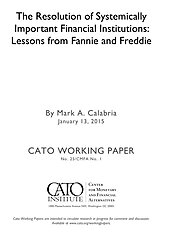An additional purpose of this paper is to provide some additional “legislative history” to the resolution mechanisms contained in the Housing and Economic Recovery Act of 2008 (HERA), which established a resolution framework for the GSEs similar to that ultimately created in Title II of Dodd-Frank. The intent is to inform current debates over the resolution of systemically important financial institutions by revisiting how such issues were debated and agreed upon in HERA.
The Resolution of Systematically Important Financial Institutions: Lessons from Fannie and Freddie
There was perhaps no issue of greater importance to the financial regulatory reforms of 2010 than the resolution, without taxpayer assistance, of large financial institutions. The rescue of firms such as AIG shocked the public conscience and provided the political force behind the passage of the Dodd-Frank Act. Such is reflected in the fact that Titles I and II of Dodd-Frank relate to the identification and resolution of large financial entities. How the tools established in Titles I and II are implemented are paramount to the success of Dodd-Frank. This paper attempts to gauge the likely success of these tools via the lens of similar tools created for the resolution of the housing government sponsored enterprises (GSEs), Fannie Mae and Freddie Mac.

